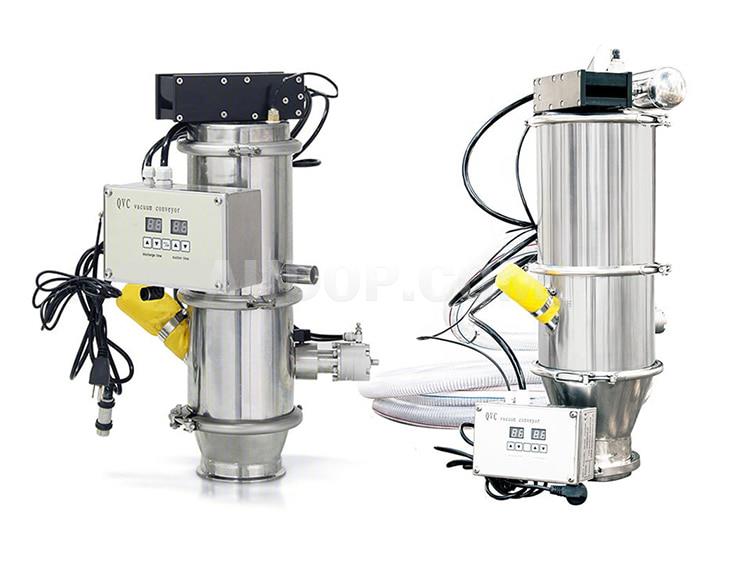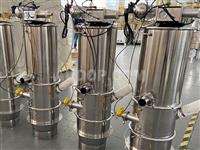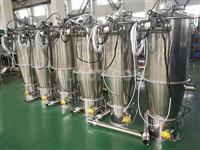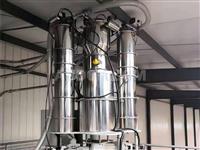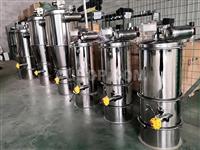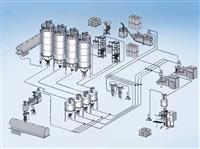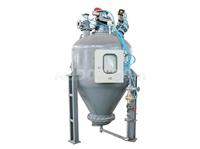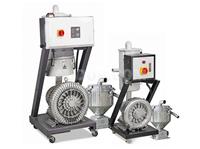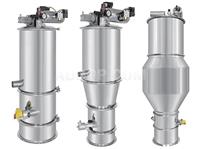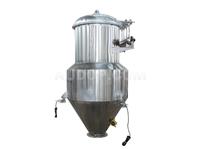Pneumatic Vacuum Feeder
- The conveying pipes of the pneumatic vacuum feeder can be flexibly configured, making the factory's production process more reasonable;
- The conveying system is fully enclosed, with minimal dust flying and escaping, ensuring environmental hygiene;
- It has few moving parts, making maintenance convenient and easy to achieve automation;
- It has high bulk material conveying efficiency, reducing packaging, loading, unloading, and transportation costs;
- It can prevent the conveyed materials from being dampened, damaged, or mixed with other impurities, thus ensuring the conveying quality;
- During the conveying process, multiple process operations can be realized simultaneously, such as mixing, crushing, classification, drying, cooling, dust removal, and other chemical reactions;
- It can realize long-distance operation of conveying materials concentrated at multiple points to one place or distributing materials from one place to multiple points;
- The pneumatic vacuum feeder has a simple structure, which is convenient for manufacturing, processing, and installation, with low control costs and short construction time;
- It has high conveying efficiency, and there is no return transportation for the equipment;
- It is conducive to realizing bulk transportation, saving packaging materials and transportation costs;
- During the conveying process, intermediate treatments such as sorting and drying can also be carried out independently;
- It can convey materials in a heated state and play a cooling role during the conveying process.
Overview
The pneumatic vacuum feeder utilizes compressed air to generate high vacuum through a vacuum generator for material conveying. It does not require a mechanical vacuum pump and features advantages such as simple structure, small size, maintenance-free operation, low noise, and easy control.The high vacuum generated by the vacuum generator eliminates material stratification during conveying, ensuring the uniformity of mixed material components. It is an ideal automatic feeding equipment for machines like tablet presses, capsule filling machines, dry granulators, packaging machines, crushers, and vibrating screens.
The QVC series vacuum conveying feeder is a type of vacuum feeder that uses a pneumatic vacuum pump as the vacuum source.With this vacuum feeding machine, materials can be directly fed from containers into mixers, reactors, hoppers, tablet presses, packaging machines, vibrating screens, pelletizers, hydraulic granulators, dry granulators, and crushers.The use of this feeder can reduce workers' labor intensity, eliminate powder pollution, and ensure that the production process meets GMP requirements.
For vacuum feeders with level control, automatic feeding is achieved through level control and the hopper of the receiving equipment.When the material level is higher than a certain position in the hopper of the receiving equipment, the pneumatic vacuum feeder stops feeding; however, when the material level is lower than a certain position in the hopper, the feeder starts feeding automatically. This completes the feeding process for the receiving equipment.
Main Features of Powder and Granule Pneumatic Conveyor:
When compressed air is supplied to the vacuum generator, the generator creates negative pressure to form a vacuum airflow. Materials are sucked into the suction nozzle, forming a material-air flow, and then reach the hopper of the feeder through the suction pipe.The filter separates materials from air. When the hopper is full of materials, the controller automatically cuts off the air supply, the vacuum generator stops working, and at the same time, the hopper door opens automatically, allowing materials to fall into the hopper of the connected equipment.At the same time, compressed air automatically cleans the filter through a pulse backblow valve. The pneumatic vacuum feeder starts automatically when the set time is up or the level sensor sends a feeding signal.The conveying capacity of the pneumatic vacuum feeder is closely related to the conveying distance and material characteristics.
Technical Parameters
Technical Parameters
| Model | Capacity(kg/h) | Consumption (NL/min) | Volume(L) | Pressure(Mpa) | Size(mm) | Weight(kg) |
| QVC-1 | 350 | 180 | 1.1 | 0.4-0.6 | Φ140x560 | 15 |
| QVC-2 | 700 | 360 | 6 | 0.4-0.6 | Φ213x720 | 40 |
| QVC-3 | 1500 | 720 | 12 | 0.4-0.6 | Φ290x850 | 60 |
| QVC-4 | 3000 | 1440 | 42 | 0.4-0.6 | Φ420x1150 | 150 |
| QVC-5 | 6000 | 2880 | 60 | 0.4-0.6 | Φ420x1150 | 200 |
| QVC-6 | 9000 | 4320 | 0.4-0.6 | Φ420x1350 | 280 |
Your requirements are the basis for our development and a daily challenge to bring to fruition, please do not hesitate to inquiry us.
Positive Pressure Conveying System
- The positive pressure conveying system is convenient for installing branch pipelines, which can convey materials to multiple places at the same time, with high production efficiency.
- The air leakage position of the positive pressure conveying system is easy to find, and the dust removal requirement for air is not high.
- The system has small conveying resistance and less wear on the pipeline.
- The positive pressure conveying system has a long conveying distance, which can reach more than 1000m.
- Air supplement pipes can be installed inside and outside the conveying pipeline, and air supplement and blockage removal can be carried out in a variety of ways.
Pneumatic Conveying Pump
- High Energy Efficiency: Due to the reasonable fluidization structure, the material fluidization state is good, and the air consumption is significantly lower than that of similar products. After years of production and research, our company has improved the fluidization structure for many times, which greatly improves production efficiency and reduces energy consumption, helping users save operating costs.
- High Material-Gas Ratio: With good fluidization effect and low air consumption, the material-gas ratio is naturally high. Through laboratory tests, when the equivalent distance is within 500 meters, the material-gas ratio can reach more than 30Kg (ash)/Kg (gas), ensuring efficient material conveying.
- Low Material Flow Rate: The material flow rate during conveying is low, which results in small wear of the equipment's valves and pipelines and long service life of vulnerable parts, reducing the frequency of equipment maintenance and replacement.
- Strong Adjustment Function: It has various adjustment methods such as primary and secondary air intake adjustment, which can make the system operate under the optimal air consumption ratio and excellent fluidization state, adapting to different material conveying conditions.
- Unique Blockage Removal Method: It adopts a back-suction blockage removal method, which is simple, easy to implement and reasonable in operation. It only needs to lead the material-gas mixture to the silo or flue inlet through the blockage removal valve and pipeline, ensuring smooth operation of the conveying system.
- Easy Solution for Supporting Facilities: Due to low air consumption and low speed, the silo material-gas separation and filtration equipment can be smaller than that equipped with general bin-type pumps, and the air pollution caused is also small, meeting environmental protection requirements.
- Small Energy Consumption Coefficient: The energy consumption coefficient of the bin-type pump conveying system is below 65KW.h/t.m, which is more energy-saving compared with similar conveying systems.
- High Degree of Automation: It adopts a programmable (PLC) control system, and the entire working process can be fully automated. The system can be set to automatic or manual operation mode. The main control cabinet is installed in the system control room, reducing manual operation intensity and improving operation accuracy.
High-Power Vacuum Loader
- High-Power Vacuum Loader is a model specially developed for scenarios with large material consumption, catering to the high-volume material needs of industrial production.
- The motor power, feeding pipe diameter and hopper capacity all adopt enlarged configurations to meet the material handling requirements of large-scale industrial operations.
- Equipped with microcomputer control, it provides material shortage and overload alarms, ensuring safe and reliable operation of the material conveying system.
- It has a small size, occupies little space and features flexible operation, making it easy to integrate into different industrial production line layouts.
- Customizable one-machine multi-hopper type vacuum loaders are available to meet the diverse material conveying needs of different industrial production lines.
Electric Vacuum Feeder
- The power source of the whole set of equipment is compressed air, and no power supply is used;
- The equipment is easy and simple to disassemble and clean;
- The equipment operates with very low noise and does not generate heat or oil pollution;
- The powder conveying process is carried out in a closed environment, without dust leakage.
Vacuum Feeder
- Simple and automatic control, with arbitrary setting of suction time, easy and convenient operation.
- Hygienic closed conveying, no dust leakage, no cross-contamination, in line with GMP standards, and sterile equipment can be provided.
- It occupies a small space, can complete the conveying of powders in narrow spaces, makes the working space neat and elegant, and is not limited by the length of the distance.
- Clean and dust-free operation, no dead ends, and quick and convenient disassembly, assembly, cleaning, and material change.
- Economical: One machine can be used for multiple sets of equipment in turn, with high efficiency and energy saving, no need for warm-up and standby, and low operation and maintenance costs.
